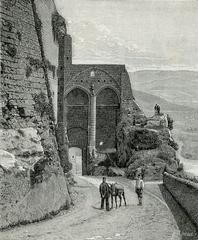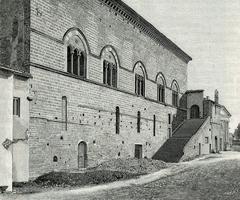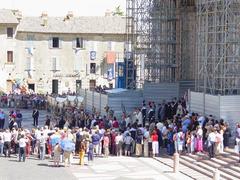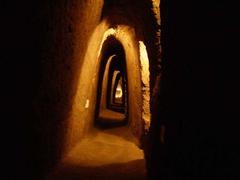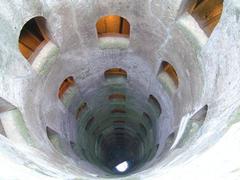San Giovanni Evangelista Orvieto: Visiting Hours, Tickets, and Complete Travel Guide
Date: 14/06/2025
Introduction
San Giovanni Evangelista in Orvieto, Italy, is a remarkable testament to the region’s layered religious, architectural, and cultural history. Perched atop the volcanic tufa plateau of Orvieto’s historic center, this church stands on ground sacred since Etruscan times, later transformed by the Romans and eventually consecrated as a Christian site in the early 10th century. Over the centuries, San Giovanni Evangelista has evolved through medieval, Renaissance, and Baroque transformations, each phase leaving visible traces in its structure and artistic heritage.
Visitors today encounter a unique blend of ancient archaeological fragments, Renaissance cloisters, and a distinctive Baroque octagonal church, all nestled within a tranquil setting that offers panoramic vistas of the Umbrian countryside. The church maintains its role as an active parish and community venue, hosting religious services, cultural events, and concerts that contribute to Orvieto’s vibrant civic life.
This comprehensive guide will provide detailed information on San Giovanni Evangelista’s history, architectural features, visiting hours, ticketing, accessibility, travel tips, and nearby attractions, ensuring a rewarding and informed visit.
For further visual resources and planning, consult OrvietoViva, Key to Umbria, and UmbriaOnline Guide.
Table of Contents
- Historical Overview
- Architectural Features
- Artistic Heritage
- Visiting Hours and Tickets
- Accessibility and Travel Tips
- Nearby Attractions
- Cultural Significance and Events
- Frequently Asked Questions (FAQ)
- Conclusion and Further Resources
- References
Historical Overview
Ancient and Medieval Foundations
San Giovanni Evangelista occupies a site with deep spiritual significance, originally dedicated to Tinia, the chief deity of the Etruscans. The later Roman occupation repurposed the area with a theater, a testament to Orvieto’s ancient habit of overlaying sacred spaces (UmbriaOnline Guide). The Christian church was founded in 916 CE by Pope John X and was expanded over the following centuries, reflecting Orvieto’s growing religious influence (Key to Umbria). By its consecration in 1216 by Pope Innocent III, the church had become a central part of Orvieto’s spiritual life, featuring multiple altars and significant liturgical furnishings.
Destruction and Baroque Rebirth
A catastrophic earthquake in 1687 destroyed much of the medieval church, prompting a complete Baroque reconstruction. The new building, completed in 1704, introduced an octagonal floor plan—a rarity in Umbria—embodying Baroque trends toward centralized, harmonious space (Wikipedia). The church’s façade was finished in 1857, and the campanile was added in 1928, maintaining architectural coherence while enhancing the structure’s visibility.
Architectural Features
Exterior
- Façade: Completed in the 19th century, the façade is understated, balancing neoclassical lines with Baroque proportions.
- Campanile: Built in 1928, the bell tower complements the church’s form and uses local tufa stone for continuity.
- Cloister: The Renaissance cloister (1513) features arcades and a central wellhead, attributed to Antonio da Sangallo il Giovane. It now forms part of the Palazzo del Gusto, a center for food and wine events (Key to Umbria).
Interior
- Octagonal Plan: The church’s unique eight-sided layout creates a sense of unity and focus, drawing attention to the altar and symbolizing regeneration, a common theme in Christian iconography.
- Embedded Archaeological Elements: The entrance walls contain Etruscan and medieval fragments, including a 4th-century Etruscan-inscribed tufa column, visually narrating the site’s long religious history.
- Materials: Local tufa stone dominates the construction, giving the church its characteristic warm hue and tying it to Orvieto’s landscape.
Artistic Heritage
Though many original artworks have been relocated to museums for preservation, San Giovanni Evangelista retains significant decorative elements:
- 14th-Century Marble Holy Water Stoup: Adorned with eagle and floral motifs, it rests on an ancient column and remains a highlight of the church’s interior (UmbriaOnline Guide).
- Medieval Frescoes: Remnants of 13th and 14th-century frescoes depicting biblical scenes and local saints provide insight into medieval devotional art.
- Madonna and Child Statue: A large wooden statue (ca. 1335), now in the Museo dell’Opera del Duomo, reflects the church’s historical artistic wealth.
Visiting Hours and Tickets
- Hours: Tuesday to Sunday, 9:00 AM – 6:00 PM. Closed Mondays and major public holidays. Hours may vary during religious services or special events (OrvietoViva).
- Tickets: Entry is free for individual visitors. Guided tours and special exhibitions may require a ticket or donation.
- Tours: Guided tours are available through local operators or the Orvieto tourism office. Booking in advance is recommended during peak seasons.
Accessibility and Travel Tips
- Physical Accessibility: The church and cloister are mostly accessible, though some internal steps and uneven flooring may present challenges. Visitors with mobility concerns should contact the parish or tourism office in advance.
- Getting There: Located in Orvieto’s historic center, San Giovanni Evangelista is about a 15-minute walk from the train station (via funicular or escalator). Local buses are available, and parking is limited in the immediate area (Orvieto Info).
- Best Times to Visit: Early mornings and late afternoons offer a tranquil atmosphere. Spring and autumn are ideal for pleasant weather and fewer crowds.
- Dress Code: Modest attire is required. Shoulders and knees should be covered, and hats removed upon entry.
- Photography: Discreet photography is allowed, but flash and tripods are prohibited to protect frescoes. Always check for posted signs or ask staff.
Nearby Attractions
- Orvieto Cathedral (Duomo): Renowned for its Gothic façade and frescoes.
- Pozzo di San Patrizio: An engineering marvel and iconic well.
- San Francesco and San Giovenale: Other historic churches reflecting Orvieto’s religious diversity.
- Palazzo del Popolo: A medieval palace hosting exhibitions and events.
- Orvieto Underground: Explore the city’s Etruscan and medieval subterranean passages.
Cultural Significance and Events
San Giovanni Evangelista continues to serve as a parish church and community center, hosting liturgies, concerts, and cultural events. Its dedication to St. John the Evangelist connects it to annual feast days and local traditions, while its role in major processions—such as Corpus Domini—links it to the broader spiritual life of Orvieto (Earth Trekkers). Special guided tours, sacred music concerts, and art exhibitions are occasionally held within its walls, enhancing its status as a living institution.
Frequently Asked Questions (FAQ)
Q: What are the visiting hours?
A: Tuesday–Sunday, 9:00 AM–6:00 PM; closed Mondays and public holidays. Check for seasonal variations.
Q: Is entry free?
A: Yes, general admission is free. Donations are welcome; special tours or events may require tickets.
Q: Are guided tours available?
A: Yes, through local operators or the Orvieto tourism office. Booking ahead is recommended.
Q: Is the church accessible for those with disabilities?
A: The entrance is at street level, but some areas have uneven flooring or steps. Contact staff for assistance.
Q: Can I take photos inside?
A: Photography is permitted, but flash and tripods are not allowed to protect artwork.
Q: How do I reach the church from the train station?
A: Take the funicular or escalator to the historic center; it’s about a 15-minute uphill walk.
Conclusion and Further Resources
San Giovanni Evangelista offers a window into Orvieto’s spiritual, artistic, and architectural evolution—from Etruscan roots to Baroque splendor. Its unique octagonal design, embedded archaeological elements, and tranquil atmosphere make it an essential stop for travelers seeking depth and authenticity in their exploration of Umbria. For a richer experience, consider pairing your visit with guided tours and exploring nearby landmarks, such as the Duomo and Orvieto Underground.
Stay updated on hours, events, and travel tips by visiting OrvietoViva, Key to Umbria, and UmbriaOnline Guide. For interactive guides and audio tours, download the Audiala app and follow our social media for the latest insights into Orvieto’s historical treasures.
References
- San Giovanni Evangelista Orvieto: History, Visiting Hours, Tickets & Nearby Attractions, UmbriaOnline Guide
- Exploring San Giovanni Evangelista in Orvieto: Key to Umbria
- San Giovanni Evangelista, Orvieto, Wikipedia
- Strictly Italy: Things to Do in Orvieto
- Earth Trekkers: Best Things to Do in Orvieto
- Orvieto Info: Practical Visitor Guide
- Walks of Italy: Visiting Orvieto
- OrvietoViva: Church of San Giovanni Evangelista
